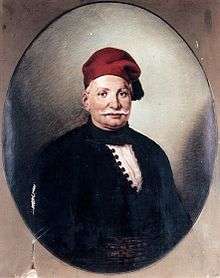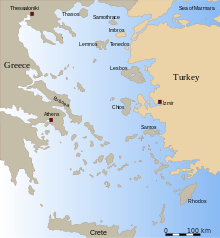Hydra (island)
Hydra (Greek: Ύδρα, pronounced [ˈiðra] in modern Greek) is one of the Saronic Islands of Greece, located in the Aegean Sea between the Myrtoan Sea and the Argolic Gulf. It is separated from the Peloponnese by a narrow strip of water. In ancient times, the island was known as Hydrea (῾Υδρέα, derived from the Greek word for "water"), a reference to the natural springs on the island.[2]
Hydra Ύδρα | |
|---|---|
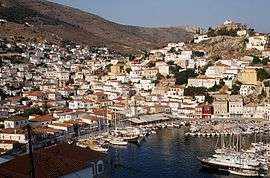 View of Hydra's port. | |
 Flag | |
 Hydra Location within the region 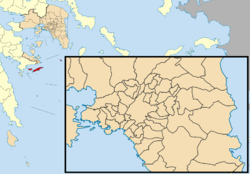 | |
| Coordinates: 37°21′N 23°28′E | |
| Country | Greece |
| Administrative region | Attica |
| Regional unit | Islands |
| Government | |
| • Mayor | George Koukoudakis (Ind.) |
| Area | |
| • Municipality | 64.443 km2 (24.882 sq mi) |
| Population (2011)[1] | |
| • Municipality | 1,966 |
| • Municipality density | 31/km2 (79/sq mi) |
| Time zone | UTC+2 (EET) |
| • Summer (DST) | UTC+3 (EEST) |
| Postal code | 180 40 |
| Area code(s) | 22980 |
| Vehicle registration | Z |
The municipality of Hydra consists of the islands Hydra (pop. 1,948, area 49.6 km2 (19.2 sq mi)), Dokos (pop. 18, area 13.5 km2 (5.2 sq mi)), and a few uninhabited islets, total area 64.443 km2 (24.9 sq mi).[3] The province of Hydra (Greek: Επαρχία Ύδρας) was one of the provinces of the Argolis and Corinthia prefecture from 1833 to 1942, Attica prefecture from 1942 to 1964, Piraeus prefecture from 1964 to 1972 and then back to Attica as part of the newly establishment Piraeus prefecture of Attica prefecture. Its territory corresponded with that of the current municipality.[4] It was abolished in 2006. Today the municipality of Hydra is part of Islands regional unit of Attica region.
There is one main town, known simply as "Hydra port" (pop. 1,900 in 2011). It consists of a crescent-shaped harbor, around which is centered a strand of restaurants, shops, markets, and galleries that cater to tourists and locals (Hydriots). Steep stone streets lead up and outward from the harbor area. Most of the local residences, as well as the hostelries on the island, are located on these streets. Other small villages or hamlets on the island include Mandraki (pop. 11), Kamini, Vlychos (19), Palamidas, Episkopi, and Molos.
Transport, tourism and leisure
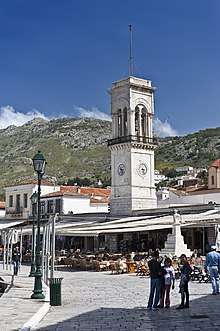
Hydra depends on tourism, and Athenians account for a sizable segment of its visitors. High-speed hydrofoils and catamarans from Piraeus, some 37 nautical miles (69 km) away, serve Hydra, stopping first at Poros before going on to Spetses. There is a passenger ferry service providing an alternative to Hydrofoils that operates between Hydra Harbour to Metochi on the Peloponnese coast. Many Athenians drive to Metochi, leave their car in the secure car park, and take the 20-minute passenger ferry across to Hydra.
Rubbish trucks are the only motor vehicles on the island, since by law, cars and motorcycles are not allowed. Horses, mules and donkeys, and water taxis provide public transportation.[5] The inhabited area, however, is so compact that most people walk everywhere.
Hydra benefits from numerous bays and natural harbours, and has a strong maritime culture. The island is a popular yachting destination and is the home of the Kamini Yacht Club, an international yacht club based in the port of Kamini.
In 2007, a National Geographic Traveler panel of 522 experts rated Hydra the highest of any Greek island (11th out of 111 islands worldwide) as a unique destination preserving its "integrity of place".[6]
Captains' mansions
The Tsamadou mansion, on the left side as one enters the harbour, is now a Maritime Academy.[7] The Tsamados family donated the mansion for the purpose of hosting the Greek Maritime Academy on their island.
The Tombazis mansion is now part of the Athens School of Fine Arts,[8] owned by University of Athens.[9]
The mansions of Lazaros and George Kountouriotis, Boudouris, Kriezis, Voulgaris, Sachinis, and Miaoulis all contain collections of 18th-century island furniture. The descendants of Lazarus Kountouriotis donated his mansion to the Historic-Ethnologic Institute of Greece. Today, it operates as an extension branch of the National Museum of History.
Monasteries and the Cathedral
There are numerous churches and six Orthodox monasteries on the island. Two particularly noteworthy monasteries are Profitis Ilias, founded in the 10th century, and Ayia Efpraxia. Both are on a hill overlooking the main harbour.
The island's cathedral is the old Monastery of the Dormition of the Virgin and sits on the quayside in the town. The monastery contains the tomb of Lazaros Kountouriotis, the richest sea captain on Hydra, who gave his entire fortune to support the Greek War of Independence.[10]
History
Pre-history, antiquity, Byzantine and Venetian era

There is evidence of farmers and herders from the second half of the third millennium BCE on the small, flat areas that are not visible from the sea. Obsidian from Milos has also been found. During the Helladic period, Hydra probably served as a maritime base for the kingdoms on the Greek peninsula. Fragments of vases, tools, and the head of an idol have been found on Mount Chorissa.
The large-scale Dorian invasion of Greece around the 12th century BCE appears to have depopulated the island. Hydra was repopulated by farmers and herders, perhaps sailing from the mainland port of Ermioni, in the 8th century BCE. Herodotus reports that toward the 6th century BCE, the island belonged to Ermioni, which sold it to Samos. Samos, in turn, ceded it to Troizina.
For much of its existence, Hydra stayed on the margins of history. The population was very small in ancient times and, except for the brief mentions in Herodotus and Pausanias, left little or no record in the history of those times.
It is clear that Hydra was populated during the Byzantine era, as vases and coins have been discovered in the area of Episkopi. However, it appears that the island again lost its population during the Latin Empire of Constantinople as its inhabitants fled the pirate depredations. On other islands, inhabitants moved inland, something that was essentially impossible on Hydra.
From 1204 to 1566, it belonged to the Venetians. From 1566 to 1821 (nominally 1829), it was part of the Ottoman Empire.
Arvanite settlement
Since 1460, Arvanites are settled on the island, refugees from Peloponnese, and create the modern town port.
In the 16th century, the island began to be settled also by refugees from the warfare between the Ottomans and Venetians.[11]
The Arvanites' presence was evident until the mid-20th century, when, according to T. Jochalas, the majority of the island's population was composed of Arvanites.[12] The island is known in Arvanitika as Nίδρα.[12]
Ottoman era: period of commercial and naval strength
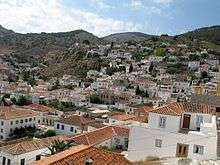
Hydra was relatively unimportant during much of the period of Ottoman rule. Its naval and commercial development began in the 17th century, and its first school for mariners was established in 1645.[13] Apparently, the first truly Hydriot vessel was launched in 1657. However, the conflict between the Republic of Venice and the Ottoman Empire limited the island's maritime development until after 1718 and the Treaty of Passarowitz. From the 17th century on, Hydra began to take on a greater importance because of its trading strength.
During the first half of the 18th century, Hydra built the same kind of vessels as were built in the other Aegean Islands: the sachtouri of 15 to 20 tons, and the latinadiko of 40 to 50 tons. The Hydriots contented themselves with trading in the Aegean, going as far as Constantinople. A great change occurred in 1757 after they launched a vessel of 250 tons. The larger boats enabled Hydra to become an important commercial port. By 1771, there were up to 50 vessels from throughout Greece in the roads. Ten years later, the island had fitted out 100 vessels.[14]
However, the Ottoman Empire and its policies constrained Hydra's economic success. Heavy tariffs and taxes limited the speed of development. The Ottoman administration limited free trade, permitting only Ottoman vessels to navigate the Dardanelles and the Bosphorus, and hence to have access to the Black Sea, its ports, and the trade in grain from their hinterlands. The Treaty of Küçük Kaynarca changed all this. Russia gained from the Ottoman Empire the right to protect the Empire's Orthodox Christians. The religious protection had a commercial corollary: the Hydriots began to sail under the Russian flag. The treaty also provided for free passage between the Aegean and the Black Sea. Hydra entered its commercial era. Hydriot vessels carried goods between Southern Russia in the east and the Italian ports of Ancona and Livorno in the west. From 1785 on, the Hydriot shippers began to engage in commerce, not just transport. Each vessel became its own small commercial enterprise, and trade with the Levant quickly began to depend on Hydra's vessels, though not without competition from those of Spetses and Psara.
The plague of 1792 killed a large part of the population, and many people moved away. As a result, the town was almost completely abandoned for a while. By the end of the 18th century, Hydra had again become quite prosperous, with its vessels trading as far as France, Spain, and even the Americas. Napoleon presented the island with the huge silver chandelier in the cathedral as a gesture of gratitude for the Hydriots' role in running the British blockade and so bringing food to France.
Greek War of Independence and later decline
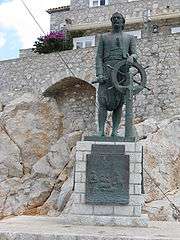

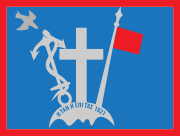
In the 19th century, Hydra was home to some 125 boats and 10,000 sailors. The mansions of the sea captains that ring the harbor are a testament to the prosperity that shipping brought to the island, which, at the time of the Greek Revolution, had 16,000 inhabitants.
To begin with, Hydriots were far from unanimous in joining the Greek War of Independence. In April 1821, when Antonis Oikonomou expelled the governor, Nikolao Kokovila and proclaimed Hydra's adherence to the independence struggle, he met strong opposition from island leaders who were reluctant to lose the relatively privileged position they had under Ottoman rule. Oikonomou was imprisoned, hounded off the island and eventually his opponents sent assassins to chase and kill him in December 1821.
Still, Hydra eventually did join the cause of independence, and Hydra's contribution of some 150 ships, plus supplies, to fight against the Turks played a critical role. The Greek admiral Andreas Miaoulis, himself a settler on Hydra, used Hydriot fire ships to inflict heavy losses on the Ottoman fleet. Eventually the fleet of Hydra - along with those of the other two naval islands of Psara and Spetses - were able to wrest control of the eastern Aegean Sea from the Ottoman Empire.
With the end of the revolution and the creation of the Greek state, the island gradually lost its maritime position in the Eastern Mediterranean, igniting an economic crisis that led to a period of hardship and unemployment. The main reason was that with the creation of the Greek state, Hydra's fleet lost the privileges that the Treaty of Küçük Kaynarca and the use of the Russian flag had given it. Another reason was that the traditional families who owned the majority of the fleet failed to foresee the benefits of participating in the steam ship revolution, which significantly cut shipping operational costs through reduced crew and independence of the winds, putting them at a disadvantage vis-á-vis the new shipping companies of Piraeus, Patras, and Syros. A third reason was that the new conditions made illegal activities such as piracy impossible. Once again, many inhabitants abandoned Hydra, leaving behind their large mansions and beautiful residences, which fell into ruin. The mainstay of the island's economy became fishing for sponge. This brought prosperity again until 1932, when Egypt forbade fishing along its coast. By World War II, the Hydriots were again leaving the island; many of them went abroad.
Second World War
Between 1941 and 1943, during the Axis occupation of Greece during World War II, there was famine on Hydra. It is estimated that some eight percent of the population died of starvation.
Historical population
| Year | Town population | Municipality/Island population |
|---|---|---|
| 1981 | 2,732 | - |
| 1991 | 2,279 | 2,387 |
| 2001 | 2,526 | 2,719 |
| 2011 | 1,900 | 1,982 |
Topography and ecology
.jpg)
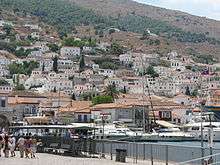
The dominant geographic features of Hydra are its rocky hillsides, which are bare, pine forested valleys with the occasional farmhouse. The island was subject to a modern geologic study by Renz in 1955. Some of the later Permian limestone strata are rich in well-preserved fossils.
There are many types of wildflowers, including rare 'spentzes' or cyclamen and poppies. As well as pine trees, there are cypress and olive trees. Birds species include partridges, quails, and many migratory birds, which are subject to local hunting. Mammals include rabbits, feral cats, and goats.
Although the island's name is derived from ancient springs known to the Ancient Greeks, it is now almost dry. Hydra previously had wells, and three new wells have been found. Today, the island imports its water by boat from the Greek mainland. A new desalinization plant has been finished but is not in operation. Many local people store winter rainfall in cisterns beneath their houses to use later as drinking water.
A savage fire during the intense heat of 2007 destroyed much of the pine forest to the east of Hydra port. However, the fire left untouched some forest above Kamini and at the west end of Hydra. The forest around Molos, Bisti, and Agios Nikolaous was also unaffected.
The island has almost no nighttime light pollution. This is a boon to astronomy.
Municipality of Hydra
The municipality of Hydra includes the following islands:
| Name | Area | Population |
|---|---|---|
| Dokos Island | 13.5 | 18 |
| Agios Georgios Island | 4.3 | 0 |
| Hydra Island | 52 | 1960 |
| Trikeri Island and more Islands | 2.2 | 4 |
The total area of the municipality is 72 km2 (28 sq mi), and its population is 1980 (2011), most in Hydra (city).
Cultural life
The Hydrama Theater and Arts Center hosts performances, drama and dance workshops for the local community, and courses in ancient Greek theater for international participants.
The island hosts an annual conference on Rebetiko, a type of Greek urban folk music, in mid-October.
In the 1950s and 1960s Hydra was the adopted home of a community of artists, expatriates from their own countries, that included celebrated Norwegian novelist Axel Jensen, Australian writers Charmian Clift and George Johnston, and Canadian singer-songwriter Leonard Cohen.[15] Cohen wrote several of his better-known songs on Hydra, including "Bird on the Wire" and "So Long, Marianne", while living with Jensen's ex-wife, Marianne Ihlen. This period was depicted in the 2019 documentary film Marianne & Leonard: Words of Love, and Polly Samson's 2020 novel A Theatre For Dreamers.
 Leonard Cohen's house
Leonard Cohen's house Overview
Overview
In June 2009, the art collector Dakis Joannou opened a Hydra branch of a private art museum, the Deste Foundation, to show the work of established young artists.
International relations
Notable people
- Laskarina Bouboulina (1771–1825) merchant, shipowner, naval heroine, admiral
- Brenda Chamberlain (artist) (1912-1971) Welsh artist and writer
- Charmian Clift (1923–1969), Australian novelist and writer
- Leonard Cohen (1934-2016), Canadian singer-songwriter, poet and novelist who spent his early song-writing career on Hydra with his girlfriend Marianne Ihlen.
- Dorotheus (1888–1957), Archbishop of Athens and All Greece
- Axel Jensen (1932–2003) Norwegian author
- George Johnston (1912–1970), Australian journalist, novelist and writer
- Gikas N. Koulouras, shipowner, member of Parliament, founded and donated the Historical Museum and Archives of Hydra, founder and first President of the Greek Shipowners Association
- Georgios Kountouriotis (1789–1858) merchant, shipowner, politician, Prime Minister of Greece
- Lazaros Kountouriotis) merchant, shipowner. The biggest funder of the Greek War of Independence.
- Pavlos Kountouriotis (1855–1935) naval hero, admiral and President of Greece
- Panayotis Koupitoris (1821-1881), writer
- Antonios Kriezis (1796–1865) merchant, shipowner, naval hero, admiral, Prime Minister of Greece
- Marios Loizides (1928–1988) was a Greek visual artist.
- Michalis Maniatis (1952) film and TV actor, producer, screen and book writer
- Andreas Miaoulis (1768–1835), merchant, shipowner, naval hero, admiral
- Athanasios Miaoulis (1815–1867) Prime Minister of Greece
- Nikos Nikolaou (1909–1986), artist
- Georgios Sachtouris, shipowner, admiral during the Greek war of Independence
- Georgios Sachinis (1789–1864), merchant, shipowner, naval hero, admiral
- Stavros Sachinis died in the Battle of Sphacteria (1825), holding off the Egyptian-Turkish landing force.
- Panayiotis Tetsis (1925–2016), painter
- Emmanouil Tombazis, merchant, shipowner, naval hero, admiral
- Iakovos Tombazis (1782–1829) merchant, shipowner, naval hero, admiral
- Rallou Manou, choreographer
- Anastasios Tsamados (1774–1825), shipowner, admiral, Greek national hero, captain of the brig Aris, died heroically in the Battle of Sphacteria (1825), holding off the Egyptian-Turkish landing force.
- Göran Tunström (1937–2000) Swedish author
- Nikolaos Vokos (1854–1902), painter
- Elena Votsi (b. 1964), jewellery designer
- Nikolaos Votsis (1877–1931), naval hero and admiral
- Dimitrios Voulgaris (1802–1878), merchant, shipowner, Prime Minister of Greece
- Gordon Merrick (1916–1988), author
Books about or set on Hydra
- The Colossus of Maroussi, Henry Miller (1941)
- Peel Me a Lotus, Charmian Clift (1959)
- The Sea Change, Elizabeth Jane Howard (1959)
- A Rope of Vines: Journal from a Greek Island, Brenda Chamberlain (1965) (ISBN 9781905762866)
- The Sleepwalker, Margarita Karapanou (1985)
- Clouds over Hydra, Charles Young (1996)
- Fugitive Pieces, Anne Michaels (1996)
- The Riders, Tim Winton (1996)
- Hydra and the Bananas of Leonard Cohen, Roger Green (2003)
- Rhubarbs from a Rock, David Fagan (2003)
- Hydra, Catherine Vanderpool (1980)
- Le Premier jour, Marc Levy (2009)
- Travels with Epicurus, Daniel Klein (2012)
- Hydra vues privées / Private views, Catherine Panchout, Éditions Gourcuff Gradenigo (2015)
- Island of Cats – Hydra, Gabriela Staebler, Edition Reuss (2015)
- Beautiful Animals, Lawrence Osborne (2017)
- Hydra. An Island and Its Architecture, Michael Loudon (2018)
- Forth Into Light, Gordon Merrick (1974)
- A Theatre for Dreamers, Polly Samson (2020)
- Half the Perfect World (writers, dreamers and drifters),Paul Genoni and Tanya Dalziell (2018)
Movies filmed on Hydra
- A Girl in Black (Greece 1956)
- Boy on a Dolphin (1957). Hydra was the setting for this Sophia Loren hit movie.
- Phaedra (1962)
- Island of Love (1963)
- Incense for the Damned (1970)
- The Blue Villa (Un Bruit Qui Rend Fou) (1995)
- Boat Trip (2002)
- Fugitive Pieces (2007)
- The Capsule (2012)
- Marianne & Leonard: Words of Love (2019)
Gallery
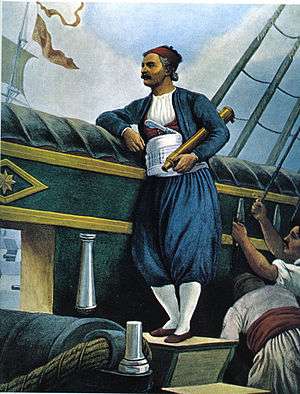 Andreas Vokos Miaoulis by Peter von Hess
Andreas Vokos Miaoulis by Peter von Hess The Epitaphios being carried, Good Friday
The Epitaphios being carried, Good Friday.jpg) Snapshot from the seafront
Snapshot from the seafront- On the left the Museum of Hydra. On the right the Tsamados mansion.
- The Museum of Hydra.
 Street
Street
References
- "Απογραφή Πληθυσμού - Κατοικιών 2011. ΜΟΝΙΜΟΣ Πληθυσμός" (in Greek). Hellenic Statistical Authority.
- "Water supply for Hydra Island Greece". www.hydradirect.com. Retrieved 2017-03-15.
- "Population & housing census 2001 (incl. area and average elevation)" (PDF) (in Greek). National Statistical Service of Greece. Archived from the original (PDF) on 2015-09-21.
- "Detailed census results 1991" (PDF). Archived from the original (PDF) on 2016-03-03. (39 MB) (in Greek and French)
- Zikakou, Ioanna. "Hydra: The Cosmopolitan Greek Island Where No Cars Are Allowed | GreekReporter.com". Retrieved 2017-03-15.
- "Travel". traveler.nationalgeographic.com.
- "Hydra National Merchant Marine Academy". www.hydra.com.gr. Retrieved 2017-03-15.
- "Athens School of Fine Arts". GRECT. Retrieved 2017-03-15.
- http://www.hydraislandgreece.com/portfolio/tombazis-mansion-hydra/
- "Cathedral of Hydra". Inside Hydra Island Greece | Hydra News & Info from Hydra Locals. 2010-11-06. Retrieved 2017-03-15.
- Vanderpool, Catherine (1980) Hydra, Athens Lycabettus Press, pp. 3-4.
- Jochalas, Titos P. (1971): Über die Einwanderung der Albaner in Griechenland: Eine zusammenfassene Betrachtung ["On the immigration of Albanians to Greece: A summary"]. München: Trofenik.
- Iles grecques, Guide Bleu, Hachette, 1998. p. 185.
- Georgios Voyatis, Le Golfe Saronique, p. 164.
-
Alex Beam (2014-11-20). "From Greece, with love". Boston Globe. Archived from the original on 2015-07-07. Retrieved 2016-08-06.
Cohen and Ihlen embarked on a 10-year long love affair/shuttle romance that found them in Oslo, Montreal and/or New York, depending on circumstance. Cohen jokingly called Ihlen his “Greek muse,” as he launched into a decade of creative fervor, culminating in the ultimate breakup song, “So Long, Marianne.” (“We met when we were almost young. . . ”)
- "Twinnings" (PDF). Central Union of Municipalities & Communities of Greece. Retrieved 2013-08-25.
- "National Commission for Decentralised cooperation". Délégation pour l’Action Extérieure des Collectivités Territoriales (Ministère des Affaires étrangères) (in French). Archived from the original on 2013-10-08. Retrieved 2013-12-26.

